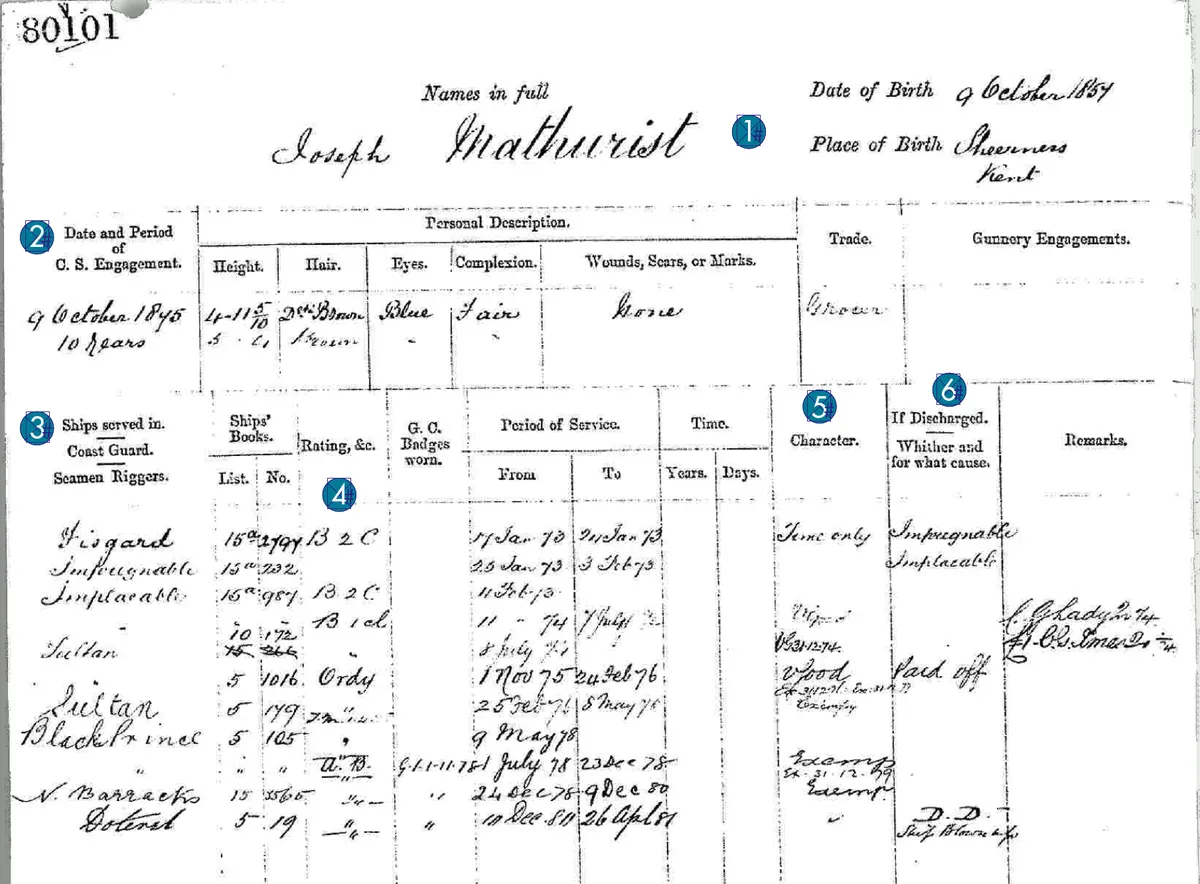Britain was a major naval power throughout the 19th century, and the Royal Navy played a key role in both the First and Second World Wars.
Luckily, it’s easier than ever to find Royal Navy service records online – and many of them are currently available for free to download from The National Archives website.
Working-class men chose to join the Royal Navy in the 19th century because it gave them employment, taught them skills, and provided meals. Despite these attractions, it should not be forgotten that before 1820 some men were press-ganged and forced to enlist against their will. There were also many charitable institutions such as the Marine Society that took in impoverished or orphan boys and trained them for naval service.
The 20th century witnessed considerable activity for the Royal Navy (RN), including two world wars and the Falklands War in 1982. Throughout this period there were many changes.
Quite apart from significant developments in ship design and armaments, the service evolved to include women among its ranks. This began with the Women’s Royal Naval Service (WRNS) in 1917, but in 1993 a separate service for women was abandoned and female personnel were fully integrated into the RN.
You will perhaps identify a Royal Navy ancestor initially because their role is mentioned in a census or a will, or because you have an old photograph of them in naval uniform.
There are many options available for exploring the career of a naval forebear, and this can be a problem because the sheer diversity and quantity of records may be a bit confusing or off-putting.
However, the good news is that the majority of records are kept in the same place – The National Archives (TNA) in Kew – and the most useful ones are now online.
It’s important to understand that Royal Navy personnel were divided into two types – officers and ratings – because the Royal Navy service records used by genealogists reflect this distinction.
Commissioned officers were the ship’s chain of command and included admirals, captains and lieutenants. Trainee officers were called midshipmen and they had to pass an exam to become a lieutenant, while warrant officers were seagoing specialists such as carpenters, engineers, gunners and paymasters.
The rest of the crew of a ship were called ratings and included seamen, ship’s boys, stokers, signalmen, cooks and many other roles.
How to find Royal Navy service records
TNA holds Royal Navy service records for officers from 1756 to 1931 and ratings from 1853 to 1928. It also has a collection of over 5000 officers' service record cards and files, dating back to roughly 1880. They are currently free to search and download online following the coronavirus lockdown and typically reveal basic biographical details such as an ancestor’s place and date of birth, as well as a list of ships served upon and any changes in rank or role.
Other online service records include records for the Royal Naval Reserve and the Merchant Navy, as well as the Women’s Royal Naval Service 1917-19.
Records for Royal Navy personnel serving after 1924, including in the Second World War are held by the Ministry of Defence. They are generally only accessible to the individual concerned or their next of kin. If you meet the criteria, you can find out how to request the records here.
Sample Royal Navy service record
This Royal Navy service record for Joseph Mathurist, a naval rating who started his career in 1873, is taken from The National Archives' online records.

Personal details
Here in the Royal Navy service record you will find your ancestor’s full name including any middle name(s); the date and place of their birth; a physical description including any tattoos; and their former occupation.
Date of formal engagement
Men had to be 18 to enlist, so Joseph’s prior service as a boy isn’t counted.
Ships served in
At the beginning of a career these are often training ships. Some ‘ships’ are in fact shore establishments.
Role
Note that their role is always abbreviated. For example, “B2C” is short for a boy second class (trainee); “Ordy” means an ordinary seaman; and “AB” is short for an able-bodied seaman.
Character
This is assessed as poor, fair, good, very good (“VG”, generally the default) or exemplary. Joseph was often exemplary.
Reasons For Discharge
“DD” means discharged dead: Joseph was killed when HMS Doterel exploded. “D” means a normal discharge (end of contract), while “Run” means that a sailor deserted.
How to find Royal Navy certificates of service
If a rating’s service record is missing, damaged or incomplete then sometimes certificates of service can help you. These were only compiled for a small proportion of personnel but they reproduced a man’s service history in order to verify whether he was entitled to, say, a pension or medal. They also date back to the very beginning of the nineteenth century before formal service records were kept. Ancestry has digitised these certificates.
How to find Royal Navy allotment registers
Allotment registers also pre-date service records, covering 1795–1812 and 1830–1852, and may enable you to trace a man’s career ship by ship. Ratings could allocate a proportion of their pay to be sent to their next of kin, who are identified in these records, and you can often track a person’s career across several ships as the registers were updated when a man changed ship. Not all men agreed to allocate wages like this, but there is a good TNA blog explaining how they worked. They have been fully indexed and can be searched via TNA's Discovery catalogue.
How to find Royal Navy officers in the Navy List
As a general method for tracing an officer’s career, you can utilise the regular contemporary publication called the Navy List, which specified every officer’s appointment on a month by month basis. It would be laborious to trace a whole career in this way but it can be helpful to fill in any gaps. Many subscription websites have copies in their collections, but you can also get some free editions online via sites such as the Internet Archive.
How to trace a Royal Navy ship
Once you know which ships your ancestor served on and when, you can then investigate the history of each ship to determine whether it played an important part in historical events. There are many websites that enable you to do this, but please note that the same ship names have been used repeatedly throughout history so make sure you have the right one! Often a general search of the internet is a useful first step to find out a bit more.
However, TNA has many original ships’ records such as logs, musters (‘roll-calls’), and pay books for wages. Enter a ship’s name into Discovery’s advance search function with appropriate dates, and confine your search to series ADM (Admiralty) and you’ll be able to see what’s available. Don’t use the ‘HMS’ precursor when searching for a ship on Discovery as you won’t get any results.
Researching ships is not always easy, so you may have to look in several places. There are books that give a brief history of naval vessels such as Colledge and Warlow’s Ships of the Royal Navy, Fifth Edition (Seaforth, 2021).
There are also details of many ships, including whole logbooks, on the free website Naval-History.net. Wikipedia can also be a good starting point for ship research.
Remember too that personnel were also deployed to land-based establishments, which despite not being afloat were, and still are, given a “His/Her Majesty’s Ship” designation. Hence HMS Raleigh is not a vessel, but a naval training base ashore at Torpoint, Cornwall, which was established during the Second World War.
How to trace First World War Royal Navy ancestors
The Royal Navy First World War Lives at Sea database can be a helpful shortcut to researching ancestors who served in this conflict. It provides a summary of the service record for everyone and can be searched by name, service number, date and place of birth, ships served on, next of kin and many other parameters.
Also, the Commonwealth War Graves Commission’s website has details of the deaths of RN servicemen in both world wars. You can limit your search to ‘Royal Navy’ to make finding your ancestor easier. The Admiralty’s medal rolls have been digitised and indexed in Ancestry’s ‘Military Collection’. These include campaign medals for the First World War, but also other events.
